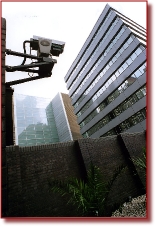 |
||
 |
||
![]()
![]()
![]()
![]()
![]()
![]()
![]()
![]()
![]()
![]()
![]()
![]()
![]()
![]()
![]()
![]()
![]()
![]()
![]()
![]()
![]()
![]()
![]()
![]()
![]()
![]()
![]()
![]()
IMPORTANT: No material may be reproduced, copied or redistributed from this site, without the express written consent of doktorjon.co.uk
All the detailed information on this site is provided in good faith; and as such, Doktor Jon does not accept responsibility for any consequential loss, injury or disadvantage resulting from any individual or organisation acting on the details contained herein.
© doktorjon.com 2004 - 2010
Remember the difference in shape between the cone of a wide angle lens (large), and a telephoto lens (narrow); well let's have a quick look at some basic figures to prove the point:-
With two identical cameras installed side by side, one fitted with a wide angle lens (0.5x magnification) and the other a telephoto (3x magnification), this is what happens:-
At 5 metres from the cameras the wide angle unit will provide an image where an adult(roughly 6 foot or 1.8 metres tall ) will fill approx. 40% of the screen height (the telephoto camera will actually fill the screen with the person from their head to their waist).
At 10 metres the wide angle will now provide an image of the adult occupying only 20% of the screen height (the telephoto is now giving coverage of the person from their knees upwards to just above the top of their head); in other words, lots of very clear and useful Evidential Quality images provided by the telephoto camera.
For the 'Cone of Containment' to work well, it’s worth considering what can easily be done to make it work more effectively.
As an example, if you think about the access / exit routes into a large shopping centre (mall), you’ll often find that there are a number of doors opening into a large unbroken space.
Working on the principle that as shoppers enter this area they are more than likely going to move around, avoiding other shoppers, looking in windows etc., it’s worth considering using some large commercial planted tubs or central aisle seating to artificially engineer the pedestrian flow into distinct parallel ‘streams’, which are themselves much easier to cover with correctly positioned video surveillance cameras.
By manipulating the direction and size of visitor flows (perhaps 2.5 metre wide corridors), it becomes much more practical to locate ‘axial’ cameras looking along the aisles, so that even from a distance, pedestrians present themselves clearly to camera, and as large targets on the monitor screen.
A working example of the 'Cone of Containment' principle in action >>>
This section is currently being further developed;
If you have any comments or suggestions, please e-mail to info[at]doktorjon.co.uk

Doktor Jon explains the 'Cone of Containment'- cont.
Well, the object of the exercise is simply to apply the principle of a ‘Cone of Containment’, to achieve two specific objectives.
Firstly, by aligning the 'cone' along the targets direction of travel, in theory they remain on screen for a much longer period of time, which results in a greater number of recorded images.
The second objective is to not only provide an Identification level evidential quality image of the target on screen, but also to maintain the size of that object for as long as possible.
![]()
![]()
![]()
![]()
![]()
![]()






